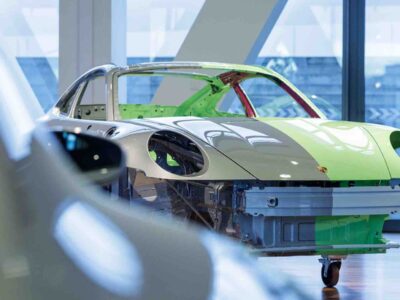Electric vehicles (EVs) are amidst a massive transformation that could see them travel farther than ever. The standard lithium-ion battery allows between 150 to 300 miles, but alternatives like solid-state lithium have been experimented with for improved distance and quicker charge times. One Michigan-based startup might have the best solution yet: a battery with 600 miles of range.
Our Next Energy (ONE) spent over a year researching and developing its creation that plays off similar ones found in Chinese automobiles and some Teslas: the anode-free battery. The results look promising, with ONE claiming its version will give EVs up to 600 miles of driving before the next charge.
A bonus is this battery type is less expensive to manufacture compared to typical lithium-ion batteries.
By eliminating the need for an anode, metals like graphite are no longer needed to act as the metal cathode for energy to sit before its returned to the battery.
“Our prismatic anode-free cell is produced with approximately half of current cell manufacturing equipment for equivalent capacity, allowing us to sharply reduce scale-up cost,” said Mujeeb Ijaz, ONE CEO and founder. If all goes according to plan, ONE’s battery could drastically improve range and allow even faster EV adoption.
The startup raised $65 million with BMW i Ventures, the venture capital division based in Silicon Valley, to get the plans off the ground. A prototype will be integrated into a BMW iX EV to test viability. According to ONE, it plans to install the battery, called Gemini, in several trucks and SUVs. The hope is that it will help EVs battle real-world driving conditions like maintaining highway speeds, winter roads, towing, and other factors that strain traditional battery ranges.
How does the Gemini work? While the makeup has yet to be revealed, ONE explains it uses different chemical reactions for power. The pack includes one devoted to power delivery for the car engine and another for energy storage. Dual chemistry allows for a 20% reduction in lithium use, a 60% reduction in the graphite used for anodes, and minimal use of nickel and cobalt.
Less raw material sourcing means these batteries will be cheaper and quicker to create. The 1007 Wh/L cell from ONE eliminates the need for graphite, enabling a $50 per kilowatt-hour cell cost at scale. “We are confident that given economic viability, this can lead to commercial opportunities and strategies to integrate ONE’s battery technologies into models of our future BEV product line-up,” said Jürgen Hildinger, BMW’s New Technologies head of high voltage storage.
Initially, anode-free batteries were not considered as useful as lithium-ion batteries because they have a lower lifespan.
ONE’s innovation differs because it pairs lithium-iron phosphate chemistries with anode-free ones, allowing for a 90% reduction in cycle and peak power for charging.
ONE claims an EV owner can plug into a direct-current charger and evenly power both chemistries because they are in one Gemini pack. Lithium-iron phosphate batteries also don’t degrade when overcharged past 100% capacity, so they can be charged daily. With this improved performance and range, ONE claims this will lead to up to 250,000 miles of lifetime service in Gemini-carrying EVs.
ONE presented the Gemini technology at The Battery Show in Novi, MI, in September 2022. The company and BMW’s anode-free technology could propel EVs into a more readily-available option for consumers. With many countries incentivizing the switch to electric cars, these developments are vital for improving the driving range and battery lifespan.





